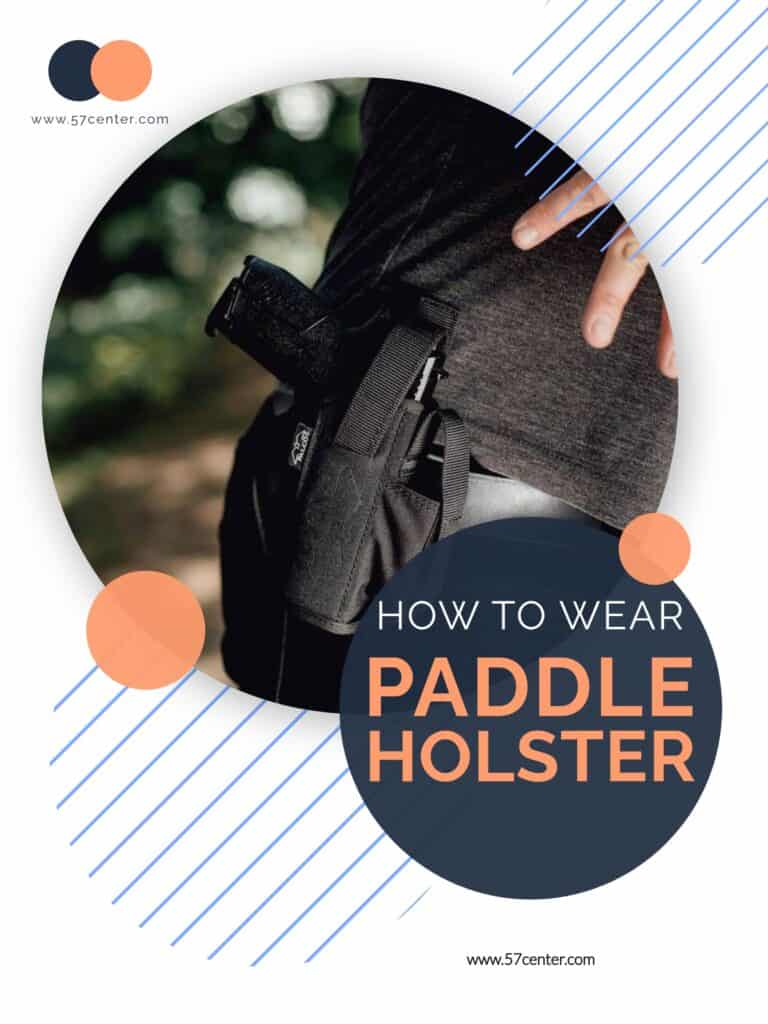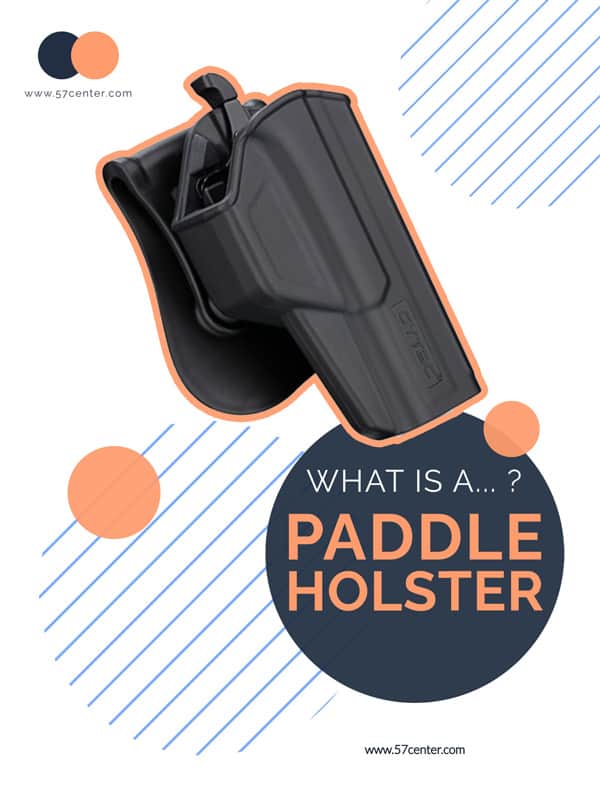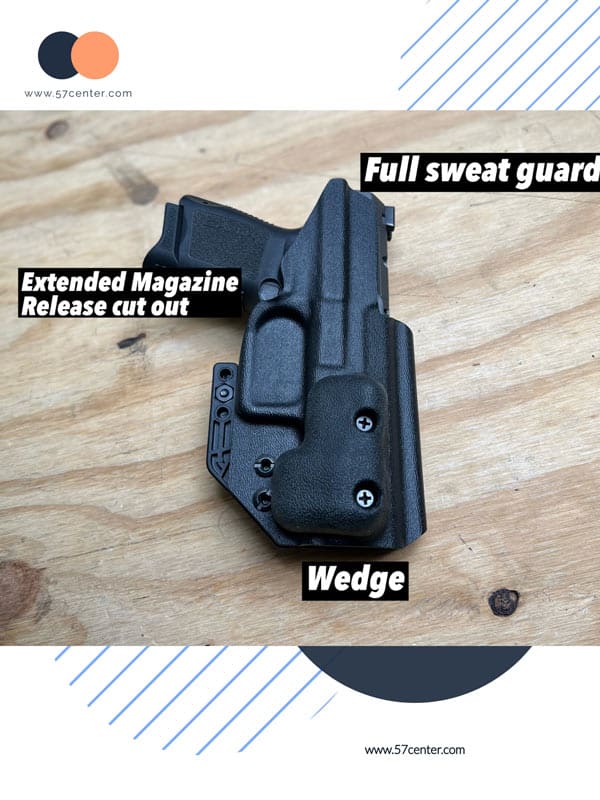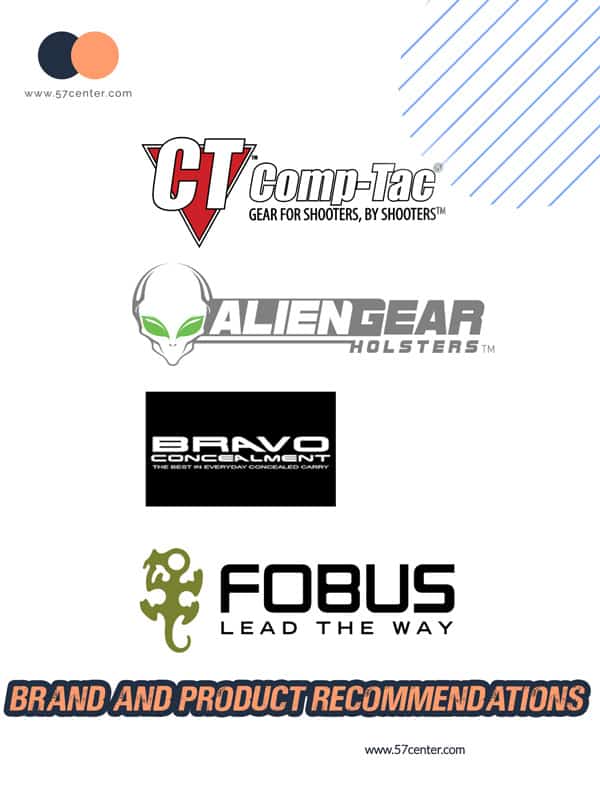When it comes to carry holsters, a paddle holster might seem a bit intimidating if you’ve heard the stories and preferences of other gun owners. But really, it’s a great holster, you just have to know how to use it right. A paddle holster is a holster that’s designed to be an OWB holster. Waistband holsters are typically very hard to conceal compared to an actual IWB holster. But, if you ask any verified owner of a paddle holster, they can tell you one thing: it’s actually pretty easy to use a paddle holster for concealed carry.

The big question is how. Today, we will discuss all the ways you can wear paddle holsters, including concealed carry and open carry applications. It’s actually a very versatile design if you can pick up a few tips.
Contents
What is a Paddle Holster?

The paddle holster actually gets its name from how it attaches to your gun belt. There’s a bracket that is on the side of the holster, which is where it will clip easily on and off from your gun belt. The belt holster clip is wide and flat, hence the “paddle” name; it looks just like a plastic paddle. This type of holster is popular with law enforcement and other carriers that might need to remove and reattach their weapon quickly.
This holster, while actually designed for the waistband holsters category, has become well known for convenient concealment. This holster model can be clipped to any part of your belt to keep your firearm secure where it is the most comfortable for you. So, I think it’s safe to say that a paddle holster is not just an OWB holster, but a concealment holster too.
The holster will sit in the waistband of your pants securely until you need to remove it. Especially with today’s gear holster designs that have adjustable retention and tough paddle materials, like a Kydex paddle. This way, your holster will have a better hold to your belt and will stay comfortable when using it.
How to Wear a Paddle Holster
Now let’s talk about the steps to properly wear or conceal a paddle holster. Just remember that all of these steps are important; the paddle holster must be worn correctly if you are trying to use it for concealed carry. Remember, it’s technically an OWB holster.
Choose a Good Paddle Holster
The first step is of course buying a paddle holster. If you don’t already have one, there’s a lot to consider here before you buy. There’s things like the method of paddle attachment, the material, the brand, and even the size. All of these will affect how your holster functions the way you need it to. This will also come down to a lot of personal preference.
Prepare Your Items
Now, before you do anything, get your weapon and your brand new paddle holster. Make sure they fit together and that there’s no compatibility issues before you start. If you’re planning on concealed carry with a pistol that has a longer barrel, then you’ll have to plan for having the holster much higher on your waistband.
This is also a great time to choose the clothes you’ll need to wear. Especially with the paddle holster, it’s important to wear loose clothes and a jacket (if feasible) to conceal your firearm properly. Since the paddle holster design tends to be larger and harder to fully conceal, then it’s best you dress to compensate for the remaining concealment that you’ll need.
Check the Safety
Before you go trying to fit up your holster, make sure your firearm’s safety is engaged. This is very important and should be a no-brainer for anyone who owns a firearm. Especially when your firearm is loaded or you are trying to fit up a new gear holster, the safety must be on. Safety first!
Have Sturdy Pants & Belt
This is another important one. Since your paddle attachment will be holding the full weight of your weapon on the waistband of your pants, it’s best if you dress for the occasion. Make sure you wear something that can stand up to the weight and not droop or sag. Also grab a belt for extra security. A belt will allow you to attach your holster easier and will provide extra reinforcement for your pants so they don’t sag.
Ready Your Holster
This step won’t apply to everyone. If you just have a holster that’s only the paddle attachment, then you can skip this one. But, a lot of holsters nowadays come with switchable attachments, like a belt loop attachment and a paddle attachment. If this is the case for you, just make sure you put the paddle attachment on your holster. It might require some tools so just check the instruction manual before you attempt the unknown.
Adjust the Retention
The retention is what will keep your gun securely in place when you carry. The adjustable retention is something you should definitely spend a few minutes getting familiar with so you know how to work it. Also spend some time adjusting and learning the belt slide vs. paddle attachment switching. Changing these is something you should know before you use the paddle holster to concealed carry.
Fit Up Your Weapon
Now that you’ve adjusted the retention and made sure you have the correct attachments, place your firearm into the paddle holster. Make sure it is a good solid fit and then just set it aside for now. If the fit isn’t perfect, try the adjustable retention again.
Benefits of Wearing a Paddle Holster
Wearing a paddle holster offers several benefits for gun owners. Understanding these advantages can help you make an informed decision when choosing the right holster for your needs.
- Quick and easy access to the firearm: Paddle holsters allow for rapid deployment of the firearm, ensuring immediate readiness in critical situations.
- Comfort and convenience for all-day carry: The paddle attachment of the holster provides stability and distributes the weight evenly, minimizing discomfort during extended periods of wear.
- Versatility for different body types and clothing options: Paddle holsters can be adjusted to accommodate various waist sizes and are compatible with different clothing styles, providing flexibility for everyday carry.
To illustrate these benefits, consider the following scenario: Imagine you’re a law enforcement officer responding to an emergency call. With a properly worn paddle holster, you can swiftly draw your firearm, ensuring your safety and the safety of others.
Tips for Comfortable and Concealed Carry
To enhance comfort and concealment while wearing a paddle holster, consider the following tips:
- Clothing choices for optimal concealment: Select clothing items that properly cover the firearm and holster, preventing printing or accidental exposure.
- Adjusting the holster cant for a natural draw motion: Experiment with different cant angles to find the most ergonomic and efficient draw motion for your body type and preferred grip style.
- Using a belt designed for paddle holsters: Some manufacturers offer specialized belts designed to enhance the stability and security of paddle holsters. Consider investing in one for an optimal carrying experience.
- Addressing common concerns or discomforts: If you experience sweating or chafing, consider wearing an undershirt or applying talcum powder to reduce friction. Additionally, choosing holsters with sweat guards or ventilation features can mitigate these issues.
Section 5: Safety Considerations and Best Practices
Safety is paramount when carrying a firearm. Here are some important considerations and best practices when using a paddle holster:
- Trigger guard protection and holster retention mechanisms: Ensure your paddle holster has a sturdy and reliable retention system that covers the trigger guard completely. This prevents accidental trigger engagement and enhances safety.
- Proper finger discipline and trigger control: Maintain a disciplined trigger finger position outside the trigger guard until you’re ready to fire. Always keep your finger away from the trigger until the threat is imminent.
- Holster maintenance and inspection: Regularly inspect your paddle holster for signs of wear, damage, or loose retention screws. Clean it as per the manufacturer’s instructions to maintain optimal functionality.
It is crucial to remember that wearing a paddle holster responsibly is not a substitute for professional training. Seek qualified instruction and practice regularly to develop safe and proficient gun handling skills.
Additional Information
You got your paddle holster all fitted up. Now, let’s go over some tips and info that you’ll need to keep in mind about your paddle holster.
Adjustable Cant
Just like the adjustable retention, there’s a measurement called cant. Cant is what adjust the angle of your firearm for more comfortable or easier drawing. Play around with the adjustment a few times to get a feel for what is best for you. Next time you hit the range, take a couple practice draws to get a feel for what will be the best cant for if you ever need to draw your concealed carry weapon.
Wear a Belt
While the paddle holster design doesn’t attach directly to the belt or belt loop, it’s better to wear one. A paddle holster is just held on by the plastic paddle and the friction of being held against your body from your pants. So, when you’re drawing your firearm or otherwise adjusting it, the paddle holster might try to pull free along with it. If you wear a belt, the edge of the holster will catch on the belt and won’t come up from your waistband. A belt will just give you some more security.
Retention Types
When it comes to paddle holsters, there’s two types of retention that we need to talk about.
Passive Retention
Passive retention is when the firearm is held in the holster mainly by friction. With some softer materials like a leather holster, this will depend on the size of the holster and the inner surface of it. A lot of other holsters will have their adjustable retention by screws, which you can tighten or loosen depending on your need.
Holsters that use passive retention tend to be open-ended, which means the barrel of your gun will stick out of the bottom. However, the modern market is moving away from just passive and most holsters now use both passive retention and active retention.
Active Retention
Active retention doesn’t rely on force or friction to keep your firearm in place, but rather a physical strap or other device. A common method is a strap that rests on the hammer of the firearm and will keep it snug in place. This method of retention is much more secure; your firearm won’t budge an inch when you use active retention. I recommend that you keep active retention on the list for what your perfect holster should have, especially if you’re more active when you carry.
Sweat Shield

Another common feature of a holster is a sweat shield. A sweat shield is a piece of material that extends from the tip of the barrel to varying lengths of the slide of the firearm. Its purpose is to protect your holster and weapon from finish wear that might come from your constant sweat where the holster sits against your skin.
It’s important to note that sweat guards are pretty controversial amongst gun owners. Some love them, some won’t even touch one. While they’re a good feature, not having one or having one isn’t that big of a deal. It’s mostly just down to your personal preference. A sweat shield can come in varying lengths, which will affect functionality, the fit of your holster, and your comfort.
Recommendations
As always, let’s end today with some brand and product recommendations.

Alien Gear
Alien Gear is a reputable holster brand and offers a wide variety of products to suit your every need. An Alien Gear holster is a great buy. For this specific topic, the Alien Gear Cloak Mod is a great, versatile paddle holster that stands up to quality and functionality.
Bravo Concealment
Another great brand is Bravo Concealment. This brand also focuses on holsters, which means they offer plenty of quality choices to help a searching gun owner like yourself.
Fobus Holster
Another holster brand. All these brands specialize in holsters, and Fobus is no different. A Fobus paddle holster is a great search and is a broad category in this company. Look here as well when you go on your holster hunt.
Comp Tac
Comp Tac offers holsters as well as mag pouches and other firearm accessories. They’re a great brand that has a lot of great options and then some.
Duty Gear
Duty Gear holsters offer products that are up to federal and police offer standards, which assures you that they are the highest of quality.
Just remember, this list is not extensive. I just listed some quality brands that are more popular, which means there are still a lot of quality brands out there that you can look. Don’t forget Concealment Express and Sig Sauer, as well as any other holster brand that you might know and love. These are just a great start if you don’t know where to look or have any other questions about your paddle holster search.
FAQs
Q: Are paddle holsters suitable for concealed carry? A: Yes, paddle holsters can be used for concealed carry. With the right clothing choices and adjustments, they can offer effective concealment.
Q: Can I wear a paddle holster without a belt? A: Paddle holsters are designed to be worn without a belt, as they attach directly to the waistband using the paddle attachment.
Q: Do paddle holsters work well for different body types? A: Yes, paddle holsters offer versatility and can be adjusted to accommodate various body types and waist sizes.
Q: How often should I inspect and clean my paddle holster? A: It is recommended to inspect your paddle holster regularly for any signs of wear or damage. Clean it as per the manufacturer’s instructions to ensure optimal performance.
Q: Can I use a paddle holster for different firearms? A: Paddle holsters are designed to fit specific firearm models or sizes. Ensure compatibility before purchasing a paddle holster for a specific firearm.
References
https://www.concealedcarry.com/firearms-ownership/sweat-guards-yea-or-nay/
https://lundestudio.com/how-to-wear-a-paddle-holster/
https://aliengearholsters.com/blog/how-to-wear-a-paddle-holster/

Brian Belko is a freelance writer and blogger. His primary areas of focus include the outdoors and shooting sports. In addition to his freelance work, Brian also writes for Wide Open Spaces and is on the Pro Staff at Military Hunting and Fishing. When he isn’t busy writing, Brian enjoys fishing farm ponds for bass and hitting the spring woods during turkey season.
